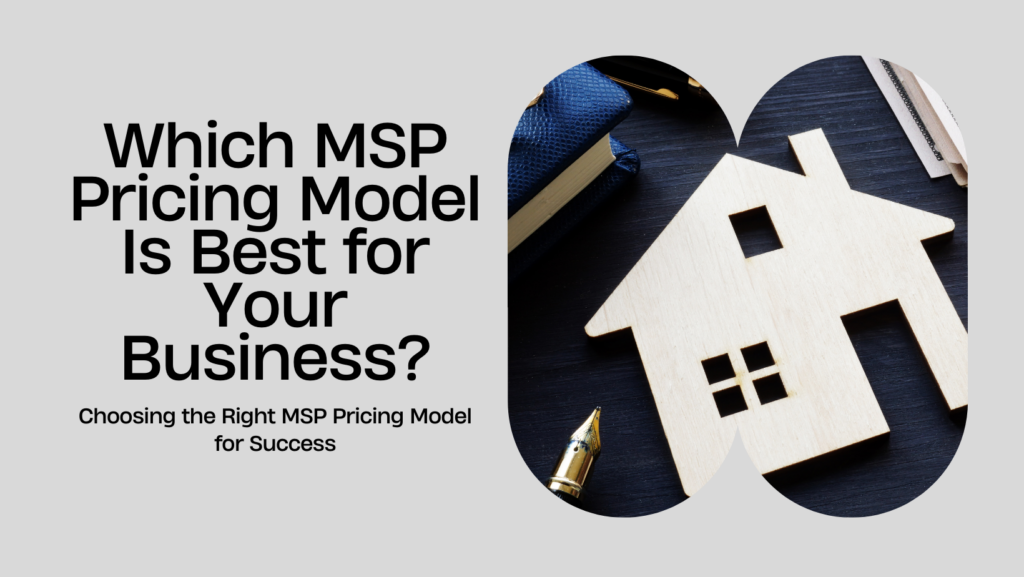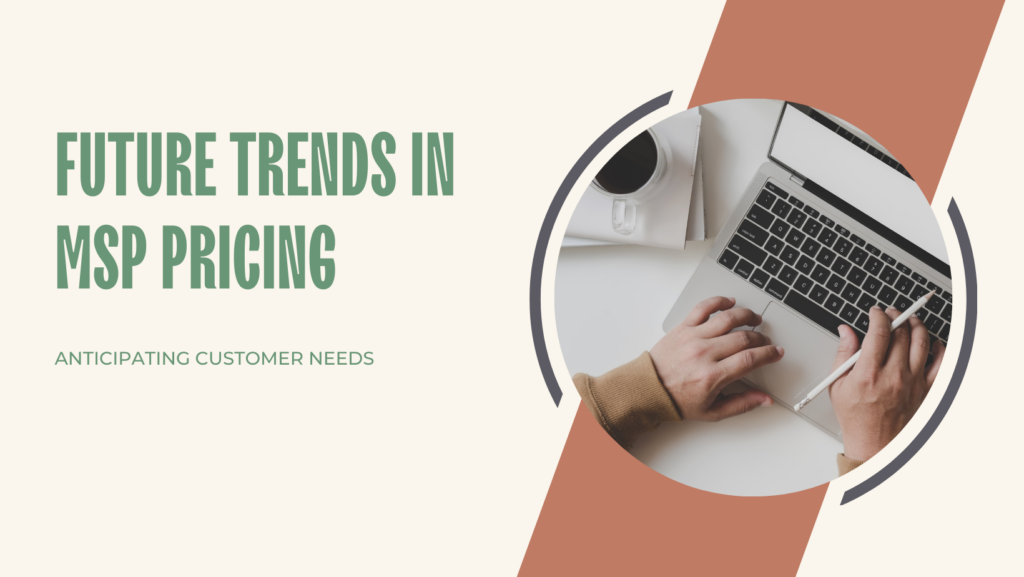Attract the right clients, cover costs, and maximize profitability by selecting the optimal MSP pricing model.
Learn about the various pricing models including per-device, per-user, tiered, and flat-fee structures, so your MSP can highlight their advantages and challenges.
With good insights, MSP decision-makers can asses their services, market demands, and operational efficiencies to determine the most suitable pricing strategy. Your MSP can align its’ pricing model with your business objectives and enhance customer satisfaction, retain competitiveness, and ensure sustainable growth!

MSP Pricing Models:
- The critical role of pricing models in the success of an MSP business.
- Overview of how the right pricing model can impact customer acquisition, service quality, and profitability.
The critical role of pricing models in the success of an MSP business cannot be overstated. MSPs (Managed Service Providers) must navigate a complex landscape where the choice of pricing model can significantly impact customer acquisition, service quality, and profitability. Selecting the right pricing model is not just about setting rates; it’s about aligning your services with client needs, market demands, and your operational efficiencies. This article explores various MSP pricing models and provides insights on choosing the best one for your business.
- Overview of Common MSP Pricing Models
- Per-Device Pricing Model. Description and how it works.Pros and cons for MSPs and their clients.
- Per-User Pricing Model. Description and advantages for scalability. Potential drawbacks and considerations.
- Tiered Pricing Model. Explanation of different tiers and customization. How tiered pricing can cater to diverse client needs.
- All-Inclusive (Flat-Fee) Pricing Model. Benefits of predictability and simplicity. Challenges in service delivery and scope creep.
- A La Carte Pricing Model. Flexibility for clients to choose specific services. Management and billing complexities.
Per-Device MSP Pricing Model
The per-device pricing model charges clients based on the number of devices managed. This model offers simplicity and transparency, making it easy for clients to understand and predict costs. For MSPs, it provides a straightforward way to scale services as client needs grow. However, it may not account for the varying levels of support required by different devices, potentially leading to uneven profitability.
Per-User Pricing Model
In the per-user pricing model, MSPs charge based on the number of users rather than devices. This approach can be advantageous for scalability, particularly for clients with a mobile or remote workforce. It simplifies billing and aligns costs with the client’s headcount. Nevertheless, it can pose challenges if user needs vary significantly, requiring careful consideration of service levels and support expectations.
Tiered Pricing Model
The tiered pricing model offers different service levels at varying price points, allowing MSPs to cater to diverse client needs. Clients can choose a tier that best fits their budget and service requirements. This model promotes flexibility and can attract a wide range of clients. However, defining and managing the boundaries between tiers can be complex, requiring clear communication and meticulous service level agreements (SLAs).
All-Inclusive (Flat-Fee) Pricing Model
The all-inclusive or flat-fee pricing model provides clients with predictability and simplicity, as they pay a single rate for comprehensive services. This model can enhance client satisfaction by eliminating unexpected costs. However, MSPs must be vigilant about scope creep, where clients demand more services than initially agreed upon, which can strain resources and affect profitability.
A La Carte Pricing Model
The a la carte pricing model allows clients to select specific services based on their needs, offering maximum flexibility. This model can appeal to clients who require specialized or limited services. For MSPs, it can lead to complex management and billing processes, as each client may have a unique service combination. Ensuring all services are adequately covered and billed can be challenging.
Case Studies and Real-Life Examples
To provide a clearer understanding of how these pricing models function in real-world scenarios, let’s delve into some case studies and examples from reliable sources:
- Syncro MSP highlights the effectiveness of the per-device model in streamlining costs and service delivery for smaller clients, particularly those with straightforward IT environments .
- ManageEngine showcases how a large enterprise successfully scaled its operations using the per-user model, accommodating a growing remote workforce without compromising on service quality .
- SuperOps provides insights into a mid-sized business that benefited from the tiered pricing model, allowing it to offer customized service levels to different departments within the organization, enhancing overall satisfaction.
- CloudBolt discusses a scenario where the flat-fee pricing model enabled an MSP to retain a major client by offering predictable costs, although it required strict management to avoid service overuse .
Evaluating Your Business Needs and Client Demands
- Assessing the nature of your MSP services and client base.
- Importance of aligning pricing models with your operational strengths and market positioning.
Assessing the Nature of Your MSP Services and Client Base
When evaluating your business needs and client demands, it’s essential to thoroughly understand the nature of your MSP services and the specific requirements of your client base. MSPs vary widely in the services they offer, from basic IT support to comprehensive managed services including cloud solutions, cybersecurity, and strategic IT planning. Understanding your service offerings in detail helps in choosing a pricing model that accurately reflects the value you provide.
For instance, if your MSP specializes in advanced cybersecurity solutions, a per-device or per-user model might not capture the complexity and expertise involved. Instead, a tiered or all-inclusive model might better reflect the comprehensive nature of your services. Assessing your client base is equally crucial; understanding their needs, budgets, and expectations will guide you in selecting a pricing model that aligns with their requirements.
Importance of Aligning Pricing Models with Your Operational Strengths and Market Positioning
Aligning your pricing model with your operational strengths and market positioning ensures that you capitalize on your competitive advantages. For example, if your MSP excels in delivering high-quality customer service and rapid response times, a flat-fee model can emphasize the value of unlimited support, enhancing client satisfaction and loyalty.
Market positioning also plays a significant role. If your MSP is positioned as a premium provider, your pricing model should reflect this by incorporating elements that highlight the superior service quality and added value. Conversely, if you target budget-conscious clients, a more straightforward per-device or a la carte model might be more appropriate.
Considerations for Selecting the Right MSP Pricing Model
- Cost Analysis and Profit Margins. Understanding the cost of service delivery. Pricing for profitability without compromising competitiveness.
- Market Competition and Standard Rates. Benchmarking against industry standards and competitors. Finding the balance between competitive pricing and value offering.
- Flexibility and Scalability. Adapting pricing models as your MSP grows. Offering scalability to meet client needs over time.

Cost Analysis and Profit Margins
Understanding the cost of service delivery is fundamental when selecting a pricing model. Conduct a thorough cost analysis to determine your expenses, including labor, tools, and overheads. This analysis will help you set prices that cover your costs and ensure profitability. Pricing for profitability means setting rates that not only cover your expenses but also provide a reasonable profit margin.
For example, if your MSP has significant costs associated with staffing support, your pricing model should reflect this by incorporating those costs into your rates. Using a flat-fee model might work if it includes all services and support, ensuring that you don’t run into losses due to scope creep. If you want to save money on staffing, there are great, reliable options such as Support Adventures’ dedicated MSP staffing services.
Market Competition and Standard Rates
Benchmarking against industry standards and competitors is crucial in finding the balance between competitive pricing and value offering. Research what similar MSPs in your market are charging and what services they include at those rates. This information helps you position your MSP competitively without underpricing your services.
For instance, if competitors offer similar services at lower rates, you might need to justify your higher prices by highlighting unique features or superior service quality. Conversely, if you’re underpricing, you could be leaving money on the table and devaluing your services.
Flexibility and Scalability
Adapting pricing models as your MSP grows is essential for long-term success. As your client base expands and your service offerings evolve, your pricing model should be flexible enough to accommodate these changes. Offering scalability to meet client needs over time ensures that your pricing structure remains relevant and competitive.
For example, starting with a per-user model might work well for a small client base, but as you grow, transitioning to a tiered model can provide more flexibility and cater to diverse client needs. Ensuring that your pricing model can scale with your business growth will help maintain profitability and client satisfaction.
Transitioning Between Pricing Models
- Strategies for evolving your pricing structure without losing clients.
- Communicating changes to existing clients to maintain trust and satisfaction.
Strategies for Evolving Your MSP Pricing Structure Without Losing Clients
Transitioning between pricing models is a delicate process that requires careful planning and execution to avoid alienating your existing client base. One effective strategy is to implement changes gradually. Start by introducing the new pricing model to new clients first, allowing you to refine and perfect the approach before rolling it out to existing clients.
Additionally, consider offering existing clients a phased transition period where they can choose to switch to the new pricing model at their own pace. Providing incentives, such as discounts or enhanced service features, can also help ease the transition. For example, offering a discounted rate for the first few months under the new model can encourage clients to make the switch more willingly.
Communicating Changes to Existing Clients to Maintain Trust and Satisfaction
Clear and transparent communication is critical when transitioning to a new pricing model. Begin by explaining the reasons behind the change, highlighting the benefits that clients will receive. Emphasize how the new model aligns with your commitment to providing high-quality service and value.
Arrange personalized meetings or calls with key clients to discuss the changes in detail, addressing any concerns they may have. Providing written documentation, such as FAQs and detailed breakdowns of the new pricing structure, can also help clarify the changes. Consistent follow-up communication to ensure clients are satisfied with the transition process will further reinforce trust and satisfaction.
Implementing and Managing Your Chosen Pricing Model
- Best practices for clear communication of pricing to clients.
- Tools and software for managing billing and service agreements.
Best Practices for Clear Communication of Pricing to Clients
When implementing a new pricing model, clarity is paramount. Ensure that all pricing details are communicated clearly and concisely to your clients. This includes providing detailed invoices that break down the costs and services rendered. Transparency helps prevent misunderstandings and builds trust.

Use multiple channels to communicate your pricing, such as emails, client portals, and face-to-face meetings. Providing examples and case studies can help clients understand how the new pricing model benefits them. Regularly reviewing and updating your pricing documentation ensures that clients are always aware of the latest information.
Tools and Software for Managing Billing and Service Agreements
Utilizing the right tools and software can streamline the management of your pricing model, ensuring accuracy and efficiency. Several tools are available that cater specifically to MSPs, helping you manage billing, service agreements, and client communication effectively.
For example, platforms like ConnectWise and Autotask offer comprehensive solutions for billing management, including automated invoicing, detailed reporting, and integration with other business tools. Syncro MSP provides features for tracking service agreements, ensuring that all aspects of the client relationship are managed smoothly.
Implementing these tools can help reduce administrative burdens, allowing you to focus on delivering high-quality services to your clients. Regularly reviewing and optimizing your billing processes and tools will ensure that your pricing model remains effective and client satisfaction remains high.
Case Studies: Successful Implementation of MSP Pricing Models
- Examples of MSPs that have effectively used different pricing models.
- Lessons learned and impacts on their business growth and client relations.
Examples of MSPs that Have Effectively Used Different MSP Pricing Models
Real-world examples provide valuable insights into the successful implementation of various MSP pricing models.
- Per-Device Pricing Model: A small MSP in the healthcare sector adopted a per-device pricing model to manage a network of medical devices. This approach allowed them to offer predictable costs, which was crucial for their clients operating on tight budgets. As highlighted by Syncro MSP, this model helped streamline their billing process and ensure steady revenue growth.
- Per-User Pricing Model: A mid-sized MSP serving the education sector transitioned to a per-user pricing model to accommodate the fluctuating number of users during different school terms. According to ManageEngine this model provided the flexibility needed to scale services based on user numbers, leading to enhanced client satisfaction and retention.
- Tiered Pricing Model: An MSP offering a wide range of IT services to various industries adopted a tiered pricing model. SuperOps reports that this approach allowed them to tailor their services to meet diverse client needs, offering basic, standard, and premium tiers. This strategy attracted a broad client base and increased overall revenue.
- Flat-Fee Pricing Model: A large MSP focusing on comprehensive IT solutions implemented a flat-fee pricing model. As detailed by CloudBolt, this model provided clients with predictable monthly costs and fostered long-term partnerships by eliminating billing surprises and enhancing trust.
Lessons Learned and Impacts on Business Growth and Client Relations
From these case studies, several key lessons emerge:
- Client Understanding: Knowing your client’s specific needs and industry requirements is crucial for selecting an appropriate pricing model.
- Flexibility: Offering flexible pricing options can attract a broader client base and cater to diverse needs.
- Clear Communication: Transparent communication about pricing changes and benefits helps maintain client trust and satisfaction.
- Regular Review: Continually reviewing and adjusting pricing models ensures they remain aligned with market demands and business growth.
Future Trends in MSP Pricing
- Anticipating changes in the market and technology that could affect pricing strategies.
- The role of value-based pricing and consultation services in future MSP offerings.

Anticipating Changes in the Market and Technology That Could Affect Pricing Strategies
As the MSP landscape evolves, several trends are likely to influence future pricing strategies:
- Increased Automation: The rise of automation tools and AI can reduce operational costs, potentially allowing MSPs to offer more competitive pricing or increase profit margins.
- Subscription-Based Models: As seen across various industries, subscription-based models providing bundled services at a flat rate could become more prevalent, offering clients simplicity and predictability.
- Customized Solutions: Tailoring services to meet specific client needs will become increasingly important, with flexible and modular pricing structures gaining traction.
The Role of Value-Based Pricing and Consultation Services in Future MSP Offerings
Value-based pricing, where fees are aligned with the perceived value delivered to the client, is set to play a significant role in future MSP offerings. This approach emphasizes the outcomes and benefits provided rather than just the services rendered. MSPs offering consultation services can leverage value-based pricing to highlight their strategic expertise and the tangible benefits they bring to clients.
For instance, an MSP helping a client achieve significant cost savings through efficient IT management or enhancing cybersecurity could justify higher fees based on the substantial value provided.
Final Words on Best MSP Pricing Models
- Recap of the importance of choosing the right pricing model for your MSP business.
- Encouragement to regularly review and adjust your pricing strategy for continued success and growth.
Recap of the Importance of Choosing the Right MSP Pricing Model for Your MSP Business
Choosing the right pricing model is a critical decision that can significantly impact an MSP’s success. The appropriate model helps attract and retain clients, ensures profitability, and aligns with the MSP’s operational strengths and market positioning.
Encouragement to Regularly Review and Adjust Your Pricing Strategy for Continued Success and Growth
Regularly reviewing and adjusting your pricing strategy is essential for staying competitive and meeting evolving client needs. As the market and technology landscape changes, being proactive in refining your pricing models will help maintain client satisfaction and drive sustainable growth.



0 Comments